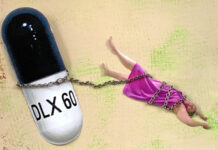Duloxetine (brand name Cymbalta) is a serotonin-norepinephrine reuptake inhibitor (SNRI) that has FDA approval to treat depression as well as fibromyalgia in adults. As with other antidepressants, it carries a “black box warning” from the FDA that it has the potential to increase suicidal thoughts and behaviors, especially in adolescents. Now, a new, as-yet-unpublished trial of duloxetine for fibromyalgia has presented more evidence of suicidal events in teens treated with this drug.
The trial is reported on at clinicaltrials.gov, where it is shown as completed. However, the trial has, as yet, been unpublished. The trial itself was sponsored by Eli Lilly, the makers of Cymbalta, and the researchers have a nondisclosure agreement with the company—meaning that they cannot publish these results unless Eli Lilly allows them to do so.
The trial data, however, is publicly available. The purpose of the study was to investigate whether duloxetine was efficacious for treating fibromyalgia in adolescents. The study included 184 children, all between the ages of 13 and 17, who had a diagnosis of Juvenile Primary Fibromyalgia Syndrome. The participants were randomly assigned to receive either duloxetine or placebo for 13 weeks (blinded treatment period); at the end of that time, all participants were given duloxetine for an additional 26 weeks (open-label period).

Duloxetine appeared to be successful for reducing fibromyalgia pain, with most measures showing a decrease when compared to placebo. However, due to duloxetine’s potential to increase suicidal thoughts and behaviors (especially in this age group), a look at the reported side effects is warranted.
The data shows that, of those taking duloxetine, six children exhibited suicide-related side-effects. There were two suicide attempts as well as an intentional overdose (the reporting system groups this separately from suicide attempts). One child engaged in self-injurious behaviors and two others exhibited suicidal thoughts that they did not act on. No participants in the placebo group had any kind of suicidal thoughts or behaviors.
Other dangerous side effects encountered by children taking duloxetine included a report of auditory hallucinations, a report of depression, a report of seizure—and two teens who developed appendicitis (compared to none in the placebo group).
In terms of less life-threatening side effects, nausea, vomiting, and headaches were commonly reported. Other side effects reported more commonly in the duloxetine group than in the placebo group included viral gastroenteritis, upper respiratory tract infection, fatigue and dizziness. Over 80% of the children in the initial duloxetine group experienced some kind of side effect, compared with around 60% in the placebo group.
Duloxetine carries FDA approval for treatment of depression, although a 2012 Cochrane review suggested that it should not be a first-line drug for this purpose. That review found that it was no more effective than any other antidepressant, but that it carried more risk of side effects. In fact, according to a 2015 Cochrane review, almost everyone taking duloxetine will experience side effects, usually nausea and vomiting and/or sleep disorders. Duloxetine is also FDA-approved for the treatment of fibromyalgia pain in adults.
****
Unpublished. Clinical Trial ID: NCT01237587















Is it really a surprise that the pharmaceutical company isn’t going to publish a study of a clinical trial with its own product getting negative results?
Report comment
A SRNI is what created my “bipolar,” so yes, the SRNI’s are dangerous, NOT “safe … meds,” as the doctors incorrectly claim. But it is a shame the “mental health professionals” as a collective, were all so stupid they couldn’t understand the words written right in their DSM-IV-TR:
“Note: Manic-like episodes that are clearly caused by somatic antidepressant treatment (e.g., medication, electroconvulsive therapy, light therapy) should not count toward a diagnosis of Bipolar I Disorder.”
Resulting in millions of children having the adverse effects of the antidepressants and/or ADHD drugs misdiagnosed as “bipolar,” as Whitaker pointed out in “Anatomy….”
And it’s a sign of the complete corruption of our psychiatric industry, and their “mental health” minion, that this iatrogenic (not “genetic”) etiology of a “bipolar” misdiagnosis, was taken out of the DSM5.
“Power tends to corrupt, and absolutely power corrupts absolutely.” The power to force treat people with these neurotoxins should be taken away from the “mental health” practicers, and all doctors. But I guess we can say “kudos” to the pharmaceutical industry for destroying the scientific validity of our medical community.
Report comment
They could understand. But they didn’t wanna… 😛
Report comment
The somatic or psychosomatic nature of fibromyalgia is unclear. Fibromyalgia could cover real biological diseases, but also a psychosomatic and even sociosomatic syndrome.
Potential biological causes should not be neglected, and treated with rigor and seriousness. But some fibromyalgia would be effectively “cured” by a psycho-social approach (reduction of stress, improvement of social relations, sport, ethnotherapy, etc.).
The French wikipedia article points out this indeterminacy of the “disease”, between the body, the society and the spirit. In particular, he emphasizes a higher prevalence of fibromyalgia among migrants, which is probably not only explained by the hard work they face, but also by the cultural shift and disorientation caused by the change of country.
Report comment
I know a number of people who have “chronic fatigue” or “fibromyalgia” and don’t think to look at the drugs they’ve been given.
Just last weekend I was talking to a woman with horrible chronic pain – supposedly “fibro” but also Hashimoto’s. It didn’t occur to her that the amitryptaline they gave her 30 years ago (that she still takes) could have messed her endocrine system….
When I hear of ***children*** with fibromyalgia, I am shocked, and believe there must be some trauma (if not drugging) involved.
And Cymbalta – I agree with Cochrane – 100% side effects. None of these drugs are effective and now that the “opioid” (really, that’s not a word) crisis is forcing GP’s to look at alternatives for pain. Sadly, these alternatives are worse than the opioids.
Report comment
The possible conversation of Eli Lilly CEO Sidney Taurel and his successor John Lechleiter on Taurel’s last day as CEO. Focus’s on Warnings of Cymbalta Withdrawal and the dangers of this horrific drug.
https://www.youtube.com/watch?v=DYzyJyVdf4c
Report comment
This is one of the most important stories that MiA has covered. And I’m glad to see the link that “The_cat” posted above. The video “The_cat” linked to is 10 years old now! I strongly recommend watching some other videos there, too. The greed, corruption, and lies of PhRMA are nothing new to regular MiA readers. I have to wonder how much $$ went into this “study” of “Cymbalta”, and WHO funded it? And, I wonder *IF* the study will be published now, or not? And *IF* the study *IS* published, I have to wonder whether it’s only being published *because* MiA “outed” it here?
Report comment
I agree that the results from this study are interesting, and should raise (or strengthen) concerns about side-effects of Cymbalta. I do think, however, that it is important to mention that in the results presented above, only one instance of suicidal ideation and one instance of appendicitis happened during the double blind treatment phase.
The remaining adverse events happened in the open-label, non-controlled, extension phase.
I do not wish to imply any intent, but I must say that I find the presentation of data above misleading at best. In the randomised phase we are talking 1 versus 0 events (I choose not to count the one case of appendicitis) – hardly convincing numbers. In the much longer extension phase we have no reasonable means of estimating what would have happened, had the patients taken placebo instead of duloxetine.
Report comment
I think AsgerPM makes a good point. I don’t think this trial points to suicidality in Duloxetine and we have to keep an open mind.
Report comment
It’s easy to say that if you have no experience with this drug.
There is a black box warning on Cymbalta – it is there for a reason, and it was quite a battle to get this small concession from Lilly.
It is criminal to prescribe this to young people for any reason. Google the phrase “Cymbalta Hell” to see why this study is representative of greater problems with this drug.
Sometimes even a small sample reflects the wider problems quite well. “Only” one suicide? Isn’t that enough?
Report comment
I will do some digging jancarol that’s a decent suggestion
Report comment
mad in america, , you can discuss all the research you want but THE PILLS ARE POISON !!! So stop discussing and realize people are getting tortured with poison. For duloxetine see https://echa.europa.eu/nl/substance-information/-/substanceinfo/100.129.057
Discussing as if people get treated with medcine is bullshit, maybe you lot can be prosecuted for these torture crimes yourself, hidding the fact that people get toxic substances instead of medicine
Report comment
But we need more research, otherwise someone might call us “anti-psychiatry”! 🙁
Report comment
I have to disagree here. I think it is very important that research be done to disprove the lies that are being spread by psychiatry. I think it’s also important NOT to use their language to describe the research, except to the extent necessary to undermine psychiatry’s facade of “scientific” pretensions. There is always the danger of being coopted, and it’s also true that many researchers have not really “got” the reality that the DSM is a science fiction novel. But in the world of academia, research speaks loudly, and most of our society believes that people who claim to be scientists will give them accurate data. I don’t see any way to undermine people’s confidence in psychiatry without presenting solid, scientific data that show it’s a bunch of crap. That certainly isn’t enough in itself, but I don’t think we can win without it.
Report comment
It totally misses the point to contend that “research” is needed to expose and discredit psychiatry. It takes no medical expertise at all, just an understanding of how language works (and is manipulated) to understand that “mental illness” is an impossible concept, hence psychiatry is an absurd field of endeavor. People aren’t stupid, they just need some validation when they see that the Empire is naked.
Report comment
awesome
Report comment